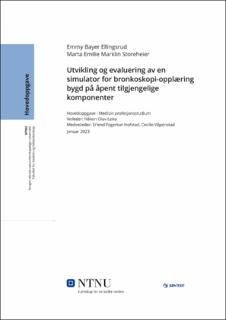| dc.contributor.advisor | Leira, Håkon Olav | |
| dc.contributor.advisor | Hofstad, Erlend Fagertun | |
| dc.contributor.advisor | Våpenstad, Cecilie | |
| dc.contributor.author | Storeheier, Marta Emilie Marklin | |
| dc.contributor.author | Ellingsrud, Emmy Bayer | |
| dc.date.accessioned | 2023-05-05T17:19:19Z | |
| dc.date.available | 2023-05-05T17:19:19Z | |
| dc.date.issued | 2023 | |
| dc.identifier | no.ntnu:inspera:118879259:44294481 | |
| dc.identifier.uri | https://hdl.handle.net/11250/3066526 | |
| dc.description.abstract | Utvikling og evaluering av en simulator for bronkoskopi-opplæring bygd på åpent tilgjengelige komponenter
Introduksjon: Bronkoskopi er lungelegers viktigste invasive verktøy for diagnostikk av infeksjoner, lungekreft og andre sykdommer. Prosedyren er velegnet for simulator-øving, likevel er ikke dette standard praksis. I dette prosjektet skal vi utvikle og teste en simulator for bronkoskopi, bestående av bronkoskop, fysisk lungemodell og navigasjonssystem. På sikt er det ønskelig at en simulator for bronkoskopi utformes for å kunne inngå i opplæringen av LIS-leger på lungeavdelingen ved St. Olavs hospital.
Metode: I denne studien ble medisinstudenter og lungeleger rekruttert og delt inn i to grupper etter kompetansenivå innen bronkoskopi. Novisene ble også delt inn i gruppe A og B etter når navigasjonssystemet ble introdusert under opplæringen. Gruppe A fikk tilgang før første test, og gruppe B etter. Alle deltakerne ble instruert til å identifisere og navigere til alle fem lungelapper, i gitt orden. Testen ble utført to ganger. Under testingen ble ni ulike måleparametere knyttet til bevegelsen av skopet registrert, og de ulike gruppene sammenlignet og analysert.
Resultater: I første test presterte de syv ekspertene signifikant bedre enn de 69 novisene etter alle måleparametre, utenom navigasjon til korrekt lapp, som ikke ga signifikante resultater. I annen test var legene fremdeles målbart bedre på simulator enn novisene, men forskjellene mellom gruppene ble mindre fremtredende. I underbyggelsen av dette, ble det registrert signifikant bedring av alle måleparametrene fra test 1 til test 2 for novisepopulasjonen. Derimot var det kun gjennomsnittshastighet som ga signifikant forbedring blant legene. Læringseffekten av selve testen ble derfor ansett som neglisjerbar. Videre var det ingen signifikant forskjell mellom novisene i gruppe A og B.
Konklusjon: Denne studien konkluderte med at simulatoren kan måle bronkoskopiske ferdigheter og skille mellom noviser og eksperter. Måleparametrene tid, bevegelseslengde og antall bevegelser viste seg spesielt egnet til måling av ferdigheter. Resultatene impliserte at simulatortrening har effekt. Denne studien klarte dog ikke å finne noen signifikant betydning av tilgangen på navigasjonssystem. Vi mener likevel at denne simulatoren, inkludert navigasjonssystem, har potensiale til å bli en del av opplæringen av LIS-leger. | |
| dc.description.abstract | Development and evaluation of a Bronchoscopy simulator based on available components
Introduction and aims: Bronchoscopy is the most important invasive procedure used in pulmonary medicine for diagnosing infections, cancer and other diseases. This is a procedure that is suitable for simulator practice, although this is not standard practice. In this project a bronchoscopy simulator, consisting of a bronchoscope, physical airway model and a tracking system, was developed and tested. The goal is to implement simulator practice in the education and training of doctors in specialization at the Department of Pulmonary Medicine at St. Olavs hospital.
Methods: Medical students and pulmonary doctors were recruited and divided into two groups according to their level of experience in bronchoscopy. The novices were also divided into two groups, A and B, where group A was introduced to the navigation system before the first test and group B after the first test. The participants were given the task to identify and navigate to the five different pulmonary lobes, in a given order. This test was conducted twice. Both expert and novice performance were registered using different evaluation metrics, and the two groups were then compared and analyzed.
Results: In the first test, the seven experts performed significantly better than the 69 novices, in terms of all metrics, except navigation to the correct lobe, which did not give significant results. In the second test, the experts proved to be significantly better in fewer of the evaluation metrics, shortening the gap between the two groups. Building on this, the novices improved significantly from test 1 to test 2 in terms of all metrics. On the other hand, the experts only had a significant improvement of “average velocity”, and therefore the learning effect of the test itself was considered to be marginal. Furthermore, there were no significant differences between novice group A and B.
Conclusion: The simulator was capable of measuring bronchoscopy skills and distinguishing between expert and novice. The metrics proven most fit to evaluate skills were “time”, “path length” and “number of movements”. The results implied that simulator training can be effective. The tracking system did not, in this study, prove to be of significant value. We believe the simulator, including a tracking system, has potential to become part of the training of pulmonary doctors. | |
| dc.language | nob | |
| dc.publisher | NTNU | |
| dc.title | Utvikling og evaluering av en simulator for bronkoskopi-opplæring bygd på åpent tilgjengelige komponenter | |
| dc.type | Master thesis | |
